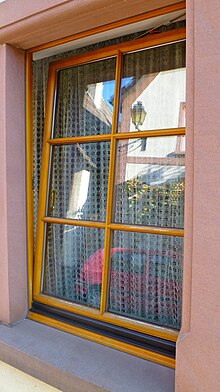Viennese rung
" Viennese bar ", also "false bar", "false bar" or "monument bar" is the name for a window bar system that consists of a two-part dummy :
- an industrially manufactured insulating glass pane , in the space of which mock-ups of “spacer profiles” made of aluminum are fitted ( inner mock-up ) and
- a matching handcrafted frame made of wood as a dummy, which is glued to the insulating glass pane ( outer dummy ).
properties
When viewed from close up, the “Wiener Sprose” should give the visual impression that it is an insulating glass window with individual insulating glass panes. In contrast to the installation of individual insulating glass panes with appropriately wide bars, the "Vienna bar" can be kept very narrow, as it is a dummy. Such a large insulating glass pane is cheaper to manufacture and lighter as a component than individual small insulating glass panes. So that the inner lattice frame made of aluminum profiles does not act as a heat conductor, it must be fitted between the insulating glass panes so that it does not touch the panes. The glued-on dummy bars made of wooden profiles must exactly cover the industrially prefabricated dummy bars made of aluminum profiles between the insulating glass panes. In order to create the illusion of individual insulating glass panes, the joint between the glued-on wooden bars and the insulating glass pane must be sprayed with silicone. Damage to this seal with silicone is only of an aesthetic nature, because it is an otherwise purposeless seal.
use
In historical buildings and monuments in particular , windows with narrow bars should give the impression from a distance that they are historical windows with single panes. In architectural monuments, windows with "Viennese muntin bars" were officially approved as an exchange for historical muntin windows, as they have narrow muntins and also give the "impression of a real muntin insulating glass unit".
criticism
Within the official preservation of monuments, the use of the "Viennese bar" as an imitation of a real bar insulating glass window, which in turn represents the historicizing imitation of a historical single window with bars , is not only controversial as an insulating glass window. The peculiarity of the Viennese muntin is that it is not primarily intended to imitate a historical muntin window, but above all a real muntin insulating glass window with individual insulating glass panes between real muntings. It has the double function of initially deceiving the observer from a distance, but then also from close up . This misleading form of window renovation contradicts a principle of monument preservation when interfering with the building structure: authenticity , workmanship and material fairness as well as reversibility of the measures for repair work on the monument should be preserved. This technical and qualitative difference between the original, a historically correct copy and an imitation becomes clear in the controversial “monument rung”.
Origin and name
This historicizing muntin system was invented by the Austrian branch of Interpane Glas Industrie GmbH in Parndorf near Vienna in 1984 and therefore bears this name.
See also
Individual evidence
- ↑ Archived copy ( memento of the original dated December 30, 2013 in the Internet Archive ) Info: The archive link was inserted automatically and has not yet been checked. Please check the original and archive link according to the instructions and then remove this notice.
- ^ Association of State Monument Preservators in the Federal Republic of Germany. Worksheet 8, Instructions for the treatment of historical windows in architectural monuments. Wiesbaden 1991, p. 3.
- ↑ Gerner, Manfred; Gardener, Dieter: Historical Windows. Development, technology, monument preservation. Stuttgart: Deutsche Verlags-Anstalt, 1996, p. 101, ISBN 3-421-03104-5
- ↑ Michael Petzet: Principles of the preservation of monuments. In: Monument preservation information . Bavarian State Office for Monument Preservation. Munich 1987.
- ^ Wolf Schmidt: Repair of historical wooden windows. In: Monument preservation information. Bavarian State Office for Monument Preservation, Munich 2004, p. 21, ISSN 1617-3147 .
- ↑ Dieter J. Martin, Michael Krautzberger: Handbuch Denkmalschutz und Denkmalpflege, Munich 2006, p. 238
- ↑ Tobias Huckfeldt, Hans-Joachim Wenk: wooden windows - construction, damage, renovation, maintenance. Cologne 2009, ISBN 978-3-481-02504-5 , p. 264.
- ↑ Deutsche Glastechnische Gesellschaft: Glass technical reports: Volume 58, 1985

